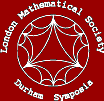| Alejandro Adem (Wisconsin) | Friday 11th July 11:20 |
| Periodic Complexes and Action Groups I |
|
|
| Alejandro Adem (Wisconsin) | Sunday 13th July 16:00 |
| Periodic Complexes and Action Groups III |
|
|
| Alejandro Adem (Wisconsin) | Saturday 12th July 16:00 |
| Periodiv Complexes and Action Groups II |
|
|
| Mladen Bestvina (Salt Lake City) | Thursday 10th July 09:00 |
| Measured foliations and Diophantine geometry |
|
|
| Brian Bowditch (Southampton) | Saturday 12th July 17:00 |
| The hyperbolicity of the curve complex |
|
|
| Marc Burger (ETH Zentrum) | Sunday 13th July 10:00 |
| Bounded cohomology and applications to group actions I |
| In the first of two talks we describe recent developments
in rigidity which stemmed from the theory of continuous bounded
cohomology for locally compact groups developed by Burger and Monod.
Notably we focus on:
1. Actions of discrete groups on hermitian symmetric spaces;
2. Orbit equivalence (Monod-Shalom)
3. Boundedness of characteristic classes for flat bundles and
more... (M.Bucher).
|
|
| Ruth Charney (Ohio State University) | Sunday 13th July 17:00 |
| Garside structures and Artin groups |
|
|
| Indira Chatterji (Cornell, USA) | Sunday 6th July 11:20 |
| New examples of groups with the Rapid Decay property |
| Joint work with Kim Ruane
We shall review the property of Rapid Decay for
discrete groups, and describe new examples of groups satisfying this
property.
|
|
| Mark Feighn (Rutgers University) | Thursday 10th July 14:30 |
| Diophantine geometry over groups V |
|
|
| Ian Hambleton (McMaster University) | Thursday 10th July 11:20 |
| Coarse topology and group actions |
|
|
| Alessandra Iozzi (ETH Zuerich, Universite de Strasbourg) | Sunday 13th July 11:20 |
| Bounded cohomology and applications to group actions II |
|
|
| Tadeusz Januszkiewicz (Wroclaw University) | Saturday 5th July 10:00 |
| Simplicial nonpositive curvature II |
| See the abstract for `Simplicial nonpositive curvature I'. |
|
| Peter Linnell (Virginia Tech) | Monday 7th July 17:00 |
| Noncommutative localization in group rings |
|
|
| Wolfgang Lueck (Muenster) | Tuesday 8th July 09:00 |
| L2 invariants I: Basic introduction to L2-Betti numbers |
| We give a list of problems which are easy to understand and seem not to be
related to L2 invariants at all. However, it will turn out that L2-methods
will actually lead to solutions. We will introduce the basic L2-invariants,
namely the L2 Betti numbers and will discuss their basic properties. Their
definition is based on some functional analysis including finite von Neumann
algebras and Hilbert modules over them. |
|
| Wolfgang Lueck (Muenster) | Thursday 10th July 16:00 |
| L2-invariants II: Further Results about L2-Betti numbers |
| There is a purely algebraic approach to L2-Betti numbers which will be
explained here. It allows one to use standard methods from homological
algebra and algebraic topology also for L2 invariants, which is not at
all obvious when one uses the functional analytic approach. This will
be one key ingredient in applications and in particular in extending all
these notiions from G-coverings of closed Riemannian manifolds to arbitrary
G-spaces such as classifying spaces of discrete groups. |
|
| Wolfgang Lueck (Muenster) | Friday 11th July 10:00 |
| L2-invariants III: The generalized dimension function |
| We will discuss applications to questions in topology, geometry and group
theory, such as S1-actions on aspherical closed manifolds, the Hopf conjecture
for non-positively curved closed Riemannian manifolds, deficiency of groups,
fundamental groups of 4-manifolds and so on. |
|
| Wolfgang Lueck (Muenster) | Saturday 12th July 09:00 |
| L2-invariants IV: Survey on further results and conjectures |
| We will discuss applications and relations of L2-invariants to projective
class groups and Grothendieck groups of group rings. We will explain
relations between the Atiyah Conjecture about the possible values of
L2-Betti numbers and the Farrell-Jones Conjecture in algebraic K-theory
and to the Bass Conjecture. |
|
| Jon McCammond (UC Santa Barbara) | Sunday 6th July 09:00 |
| Constructing nonpositively curved spaces and groups I |
|
|
| Jon McCammond (UC Santa Barbara) | Monday 7th July 16:00 |
| Constructing nonpositively curved spaces and groups II |
|
|
| Jon McCammond (UC Santa Barbara) | Saturday 12th July 10:00 |
| Constructing nonpositively curved spaces and groups III |
|
|
| Jon McCammond (UC Santa Barbara) | Sunday 13th July 09:00 |
| Constructing nonpositively curved spaces and groups IV |
|
|
| Guido Mislin (ETH Zurich) | Friday 11th July 16:30 |
| On the Geoghegan conjecture |
|
|
| Lee Mosher (Rutgers NJ) | Saturday 5th July 14:00 |
| Quasi-isometric rigidity, and the homology and dynamics of class groups II |
|
|
| Lee Mosher (Rutgers NJ) | Monday 7th July 09:00 |
| Quasi-isometric rigidity, and the homology and dynamics of class groups III |
|
|
| Lee Mosher (Rutgers NJ) | Tuesday 8th July 10:00 |
| Quasi-isometric rigidity, and the homology and dynamics of class groups IV |
|
|
| Lee Mosher (Rutgers NJ) | Sunday 6th July 10:00 |
| Quasi-isometric rigidity, and the homology of Mapping Class Groups I |
|
|
| Thomas Mueller (QM, University of London) | Saturday 5th July 17:00 |
| Character Theory of Symmetric Groups, Subgroup Growth of Fuchsian Groups, and Random Walks |
|
|
| Bob Oliver (Paris 13) | Friday 11th July 09:00 |
| Local structure of finite groups and their classifying spaces III: the Martino-Priddy conjecture |
|
|
| Bob Oliver (Paris 13) | Thursday 10th July 10:00 |
| Local structure of finite groups and their
classifying spaces II: p-local finite groups |
|
|
| Bob Oliver (Paris 13) | Tuesday 8th July 17:00 |
| Local structure of finite groups and their classifying spaces I: on BG^p |
|
|
| Mark Sapir (Vanderbilt University) | Thursday 10th July 17:00 |
| Diagram groups of directed 2-complexes, spaces of positive paths, homology and homotopy |
| (joint with Victor Guba) Diagram groups are fundamental groups of
spaces of positive paths of directed 2-complexes. These spaces are
K(.,1)
and their universal covers are CAT(0) cubical complexes. In
particular, the
R. Thompson group F is the diagram group of the Dunce hat. This fact
allows
us to find cenralizers of elements in F, solve conjugacy problem
there, etc.
We show that universal covers of spaces of positive paths are
themselves
spaces of positive
paths of the so called rooted 2-trees. Using that, we prove that all
homology groups of diagram groups are free abelian, and that the
diagram
groups are bi-orderable. We construct many new examples of infinite
dimensional
FP¥ groups with rational Poincare series, show that basically
"any"
rational function can be the Poincare function of an FP¥ group.
We also
construct an FP¥ diagram group containing all countable diagram
groups.
I am going to talk also about representations of diagram groups by
homeomorphisms of the real line, and about rigidity results involving
diagram groups. The latter results are similar in spirit to the flat
torus
theorem but the groups involved are more complicated.
|
|
| Zlil Sela (Jerusalem) | Sunday 6th July 16:00 |
| Diophantine geometry over groups I |
|
|
| Zlil Sela (Jerusalem) | Monday 7th July 10:00 |
| Diophantine geometry over groups II |
|
|
| Zlil Sela (Jerusalem) | Tuesday 8th July 16:00 |
| Diophantine geometry over groups III |
|
|
| Jacek Swiatkowski (University of Wroclaw) | Tuesday 31st December : |
| Nonpositive simplicial curvature. |
| In a recent joint work with T. Januszkiewicz, we introduce a combinatorial
condition for simplicial complexes that mimicks nonpositive curvature. It is
expressed in terms of links of a simplicial complex. Its consequences are
similar to those of classical nonpositive curvature condition for geodesic
metric spaces. In particular, it implies asphericity of simplicial complexes
and developability of complexes of groups. There is also a nice notion of
convexity of subcomplexes, implying injectivity of fundamental groups. The new
notions seem to cover numerous examples which are not (or at least not easily
seen to be) nonpositively curved in the classical sense.
We apply the above ideas in various interesting constructions described in the
proposed talk by T. Januszkiewicz on the same conference. |
|
| Jacek Swiatkowski (University of Wroclaw) | Saturday 5th July 09:00 |
| Simplicial nonpositive curvature I |
| In a recent joint work with T. Januszkiewicz, we introduce a
combinatorial condition for simplicial complexes that mimicks
nonpositive curvature. It is expressed in terms of
links of a simplicial complex. Its consequences are similar to those
of classical nonpositive curvature condition for geodesic metric
spaces. In particular, it implies asphericity
of simplicial complexes and developability of complexes of
groups. There is also a nice notion of convexity of subcomplexes,
implying injectivity of fundamental groups. The
new notions seem to cover numerous examples which are not (or at least
not easily seen to be) nonpositively curved in the classical sense. We
apply the above ideas in various interesting constructions described
in the proposed talk by T. Januszkiewicz on the same conference. |
|
| Alain Valette (Universite de Neuchâtel) | Sunday 6th July 17:00 |
| Vanishing results for the first L2-Betti number |
|
|
| Karen Vogtmann (Cornell University) | Monday 7th July 11:20 |
| Forested graphs and Morita cycles in Outer space |
|
|
| John Wilson (Birmingham) | Saturday 5th July 11:20 |
| Aspects of growth of groups |
|

